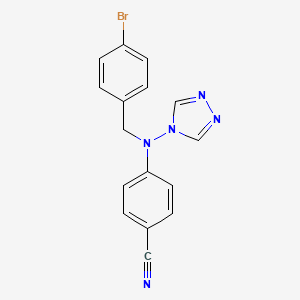
Selumetinib
Vue d'ensemble
Description
Sélumétinib, commercialisé sous le nom de Koselugo, est un médicament principalement utilisé pour le traitement de la neurofibromatose de type 1 (NF-1) chez les enfants âgés de deux ans et plus. La NF-1 est une maladie génétique du système nerveux qui provoque la croissance de tumeurs sur les nerfs . Le sélumétinib est un inhibiteur sélectif de la protéine kinase activée par les mitogènes 1 et 2 (MEK1/2), qui sont des composants clés de la voie de signalisation Raf-MEK-ERK .
Applications De Recherche Scientifique
Selumetinib has a wide range of scientific research applications, including:
Chemistry: Used as a tool to study the Raf-MEK-ERK signaling pathway and its role in various cellular processes.
Biology: Investigated for its effects on cell growth, differentiation, and apoptosis in various cell lines.
Industry: Utilized in the development of targeted therapies for cancer treatment.
Mécanisme D'action
Target of Action
Selumetinib, also known as AZD6244 or ARRY-142886, is a highly specific inhibitor of mitogen-activated protein kinase 1/2 (MEK1/2) . MEK1/2 are key components of the Ras-Raf-MEK-ERK signaling pathway, which plays a crucial role in the survival, propagation, and drug resistance of human cancers .
Mode of Action
This compound works by selectively binding to MEK1/2 proteins, thereby inhibiting their activity . This inhibition prevents the phosphorylation and activation of extracellular signal-regulated kinases (ERK1/2), which are the sole targets of MEK . By blocking this critical step, this compound effectively arrests the MAPK-ERK signaling pathway .
Biochemical Pathways
The MAPK-ERK pathway is often overactive in various types of cancers, leading to uncontrolled cell growth and proliferation . By inhibiting MEK1/2, this compound disrupts this pathway, leading to a decrease in cellular growth, cell cycle arrest in the G1-S phase, and induction of apoptosis .
Pharmacokinetics
This compound and its active metabolite, N-desmethyl this compound, have been well characterized in both adults and children . Both compounds exhibit rapid absorption and mean terminal elimination half-lives of about 7.5 hours, with minimal accumulation at steady state . Factors such as food intake, weight metrics, age, co-administration of cytochrome modulators, and Asian ethnicity can significantly influence this compound’s apparent oral clearance .
Result of Action
The primary result of this compound’s action is the shrinkage of associated tumors, as seen in patients with Neurofibromatosis type 1 (NF-1) who have symptomatic, inoperable plexiform neurofibromas (PN) . This leads to positive clinical outcomes, including a decrease in symptoms and improved quality of life .
Action Environment
For instance, food intake has been identified as a significant covariate on this compound absorption . Therefore, understanding these factors and tailoring treatment plans accordingly can help optimize the therapeutic benefits of this compound.
Méthodes De Préparation
Le sélumétinib est synthétisé par un processus chimique en plusieurs étapesLa dernière étape implique la formation du groupe carboxamide . Les méthodes de production industrielle impliquent généralement l'optimisation des conditions de réaction pour maximiser le rendement et la pureté tout en minimisant la formation d'impuretés.
Analyse Des Réactions Chimiques
Le sélumétinib subit plusieurs types de réactions chimiques, notamment :
Oxydation : Le sélumétinib est sensible à l'oxydation, ce qui conduit à la formation d'un dérivé amide.
Photooxydation : L'exposition à la lumière peut provoquer une photooxydation, entraînant la formation d'un dérivé ester.
Hydrolyse : Le sélumétinib peut subir une hydrolyse en conditions acides ou basiques, ce qui conduit à la dégradation du composé.
Les réactifs et les conditions courantes utilisés dans ces réactions comprennent les agents oxydants, l'exposition à la lumière et les solutions acides ou basiques. Les principaux produits formés à partir de ces réactions sont les dérivés amide et ester.
Applications de recherche scientifique
Le sélumétinib a une large gamme d'applications de recherche scientifique, notamment :
Mécanisme d'action
Le sélumétinib exerce ses effets en inhibant sélectivement MEK1 et MEK2, qui sont des composants clés de la voie de signalisation Raf-MEK-ERK . En inhibant ces protéines, le sélumétinib bloque la signalisation en aval qui favorise la prolifération et la survie cellulaire. Cette inhibition conduit à l'arrêt du cycle cellulaire en phase G1-S et induit l'apoptose dans les cellules cancéreuses .
Comparaison Avec Des Composés Similaires
Le sélumétinib est comparé à d'autres inhibiteurs de MEK tels que le trametinib et le cobimétinib. Bien que les trois composés ciblent les protéines MEK1/2, le sélumétinib est unique dans sa structure chimique et ses propriétés pharmacocinétiques . Par exemple, le trametinib et le cobimétinib ont des structures moléculaires différentes et peuvent présenter des profils d'efficacité et de sécurité différents en contexte clinique .
Composés similaires
- Trametinib
- Cobimétinib
- Binimétinib
Le caractère unique du sélumétinib réside dans son affinité de liaison spécifique et sa sélectivité pour MEK1/2, ce qui contribue à son efficacité dans le traitement de la neurofibromatose de type 1 et d'autres tumeurs .
Propriétés
IUPAC Name |
6-(4-bromo-2-chloroanilino)-7-fluoro-N-(2-hydroxyethoxy)-3-methylbenzimidazole-5-carboxamide | |
|---|---|---|
| Source | PubChem | |
| URL | https://pubchem.ncbi.nlm.nih.gov | |
| Description | Data deposited in or computed by PubChem | |
InChI |
InChI=1S/C17H15BrClFN4O3/c1-24-8-21-16-13(24)7-10(17(26)23-27-5-4-25)15(14(16)20)22-12-3-2-9(18)6-11(12)19/h2-3,6-8,22,25H,4-5H2,1H3,(H,23,26) | |
| Source | PubChem | |
| URL | https://pubchem.ncbi.nlm.nih.gov | |
| Description | Data deposited in or computed by PubChem | |
InChI Key |
CYOHGALHFOKKQC-UHFFFAOYSA-N | |
| Source | PubChem | |
| URL | https://pubchem.ncbi.nlm.nih.gov | |
| Description | Data deposited in or computed by PubChem | |
Canonical SMILES |
CN1C=NC2=C1C=C(C(=C2F)NC3=C(C=C(C=C3)Br)Cl)C(=O)NOCCO | |
| Source | PubChem | |
| URL | https://pubchem.ncbi.nlm.nih.gov | |
| Description | Data deposited in or computed by PubChem | |
Molecular Formula |
C17H15BrClFN4O3 | |
| Source | PubChem | |
| URL | https://pubchem.ncbi.nlm.nih.gov | |
| Description | Data deposited in or computed by PubChem | |
DSSTOX Substance ID |
DTXSID3048944 | |
| Record name | Selumetinib | |
| Source | EPA DSSTox | |
| URL | https://comptox.epa.gov/dashboard/DTXSID3048944 | |
| Description | DSSTox provides a high quality public chemistry resource for supporting improved predictive toxicology. | |
Molecular Weight |
457.7 g/mol | |
| Source | PubChem | |
| URL | https://pubchem.ncbi.nlm.nih.gov | |
| Description | Data deposited in or computed by PubChem | |
Mechanism of Action |
The Ras-Raf-MEK-ERK signaling cascade is known to be activated in several types of cancer, and regulates the transcription of proteins involved in apoptosis. In addition, studies have shown that mutations of the Raf component of the pathway can contribute to chemotherapy drug resistance. Ras as well as several kinases and phosphatases are responsible for regulating the Raf-MEK-ERK pathway. Often in cancers, Ras (a G-protein coupled receptor) is deregulated, allowing downstream signalling to proceed unchecked. Through several complex steps, Raf phosphorylates and activates MEK, which then phosphorylates and activates ERK. ERK is then able to exert its effects on several downstream targets. As such, therapies inhibiting upstream components of this pathway have become attractive targets for cancer treatment. Selumetinib exerts its effects by selectively inhibiting MEK1 and MEK2 which can effectively blunt the pleiotropic effects of the Ras-Raf-MEK-ERK cascade. By inhibiting this oncogenic pathway, selumetinib reduces cell proliferation, and promotes pro-apoptotic signal transduction. | |
| Record name | Selumetinib | |
| Source | DrugBank | |
| URL | https://www.drugbank.ca/drugs/DB11689 | |
| Description | The DrugBank database is a unique bioinformatics and cheminformatics resource that combines detailed drug (i.e. chemical, pharmacological and pharmaceutical) data with comprehensive drug target (i.e. sequence, structure, and pathway) information. | |
| Explanation | Creative Common's Attribution-NonCommercial 4.0 International License (http://creativecommons.org/licenses/by-nc/4.0/legalcode) | |
CAS No. |
606143-52-6 | |
| Record name | Selumetinib | |
| Source | CAS Common Chemistry | |
| URL | https://commonchemistry.cas.org/detail?cas_rn=606143-52-6 | |
| Description | CAS Common Chemistry is an open community resource for accessing chemical information. Nearly 500,000 chemical substances from CAS REGISTRY cover areas of community interest, including common and frequently regulated chemicals, and those relevant to high school and undergraduate chemistry classes. This chemical information, curated by our expert scientists, is provided in alignment with our mission as a division of the American Chemical Society. | |
| Explanation | The data from CAS Common Chemistry is provided under a CC-BY-NC 4.0 license, unless otherwise stated. | |
| Record name | Selumetinib [USAN:INN] | |
| Source | ChemIDplus | |
| URL | https://pubchem.ncbi.nlm.nih.gov/substance/?source=chemidplus&sourceid=0606143526 | |
| Description | ChemIDplus is a free, web search system that provides access to the structure and nomenclature authority files used for the identification of chemical substances cited in National Library of Medicine (NLM) databases, including the TOXNET system. | |
| Record name | Selumetinib | |
| Source | DrugBank | |
| URL | https://www.drugbank.ca/drugs/DB11689 | |
| Description | The DrugBank database is a unique bioinformatics and cheminformatics resource that combines detailed drug (i.e. chemical, pharmacological and pharmaceutical) data with comprehensive drug target (i.e. sequence, structure, and pathway) information. | |
| Explanation | Creative Common's Attribution-NonCommercial 4.0 International License (http://creativecommons.org/licenses/by-nc/4.0/legalcode) | |
| Record name | Selumetinib | |
| Source | EPA DSSTox | |
| URL | https://comptox.epa.gov/dashboard/DTXSID3048944 | |
| Description | DSSTox provides a high quality public chemistry resource for supporting improved predictive toxicology. | |
| Record name | 5-[(4-bromo-2-chlorophenyl)amino]-4-fluoro-N-(2-hydroxyethoxy)-1-methyl-1H-1,3-benzodiazole-6-carboxamide | |
| Source | European Chemicals Agency (ECHA) | |
| URL | https://echa.europa.eu/information-on-chemicals | |
| Description | The European Chemicals Agency (ECHA) is an agency of the European Union which is the driving force among regulatory authorities in implementing the EU's groundbreaking chemicals legislation for the benefit of human health and the environment as well as for innovation and competitiveness. | |
| Explanation | Use of the information, documents and data from the ECHA website is subject to the terms and conditions of this Legal Notice, and subject to other binding limitations provided for under applicable law, the information, documents and data made available on the ECHA website may be reproduced, distributed and/or used, totally or in part, for non-commercial purposes provided that ECHA is acknowledged as the source: "Source: European Chemicals Agency, http://echa.europa.eu/". Such acknowledgement must be included in each copy of the material. ECHA permits and encourages organisations and individuals to create links to the ECHA website under the following cumulative conditions: Links can only be made to webpages that provide a link to the Legal Notice page. | |
| Record name | SELUMETINIB | |
| Source | FDA Global Substance Registration System (GSRS) | |
| URL | https://gsrs.ncats.nih.gov/ginas/app/beta/substances/6UH91I579U | |
| Description | The FDA Global Substance Registration System (GSRS) enables the efficient and accurate exchange of information on what substances are in regulated products. Instead of relying on names, which vary across regulatory domains, countries, and regions, the GSRS knowledge base makes it possible for substances to be defined by standardized, scientific descriptions. | |
| Explanation | Unless otherwise noted, the contents of the FDA website (www.fda.gov), both text and graphics, are not copyrighted. They are in the public domain and may be republished, reprinted and otherwise used freely by anyone without the need to obtain permission from FDA. Credit to the U.S. Food and Drug Administration as the source is appreciated but not required. | |
Synthesis routes and methods
Procedure details





Retrosynthesis Analysis
AI-Powered Synthesis Planning: Our tool employs the Template_relevance Pistachio, Template_relevance Bkms_metabolic, Template_relevance Pistachio_ringbreaker, Template_relevance Reaxys, Template_relevance Reaxys_biocatalysis model, leveraging a vast database of chemical reactions to predict feasible synthetic routes.
One-Step Synthesis Focus: Specifically designed for one-step synthesis, it provides concise and direct routes for your target compounds, streamlining the synthesis process.
Accurate Predictions: Utilizing the extensive PISTACHIO, BKMS_METABOLIC, PISTACHIO_RINGBREAKER, REAXYS, REAXYS_BIOCATALYSIS database, our tool offers high-accuracy predictions, reflecting the latest in chemical research and data.
Strategy Settings
| Precursor scoring | Relevance Heuristic |
|---|---|
| Min. plausibility | 0.01 |
| Model | Template_relevance |
| Template Set | Pistachio/Bkms_metabolic/Pistachio_ringbreaker/Reaxys/Reaxys_biocatalysis |
| Top-N result to add to graph | 6 |
Feasible Synthetic Routes
Avertissement et informations sur les produits de recherche in vitro
Veuillez noter que tous les articles et informations sur les produits présentés sur BenchChem sont destinés uniquement à des fins informatives. Les produits disponibles à l'achat sur BenchChem sont spécifiquement conçus pour des études in vitro, qui sont réalisées en dehors des organismes vivants. Les études in vitro, dérivées du terme latin "in verre", impliquent des expériences réalisées dans des environnements de laboratoire contrôlés à l'aide de cellules ou de tissus. Il est important de noter que ces produits ne sont pas classés comme médicaments et n'ont pas reçu l'approbation de la FDA pour la prévention, le traitement ou la guérison de toute condition médicale, affection ou maladie. Nous devons souligner que toute forme d'introduction corporelle de ces produits chez les humains ou les animaux est strictement interdite par la loi. Il est essentiel de respecter ces directives pour assurer la conformité aux normes légales et éthiques en matière de recherche et d'expérimentation.
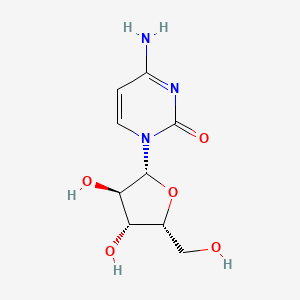
![1-Ethyl-4-[(1E,3E,5E,7E,9E,11E,13E,15E,17E)-18-(1-ethylpyridin-1-ium-4-yl)-3,7,12,16-tetramethyloctadeca-1,3,5,7,9,11,13,15,17-nonaenyl]pyridin-1-ium;dibromide](/img/structure/B1684252.png)
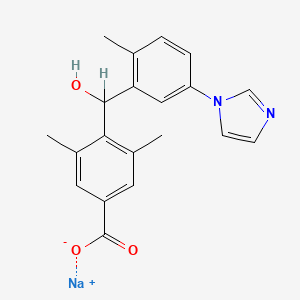
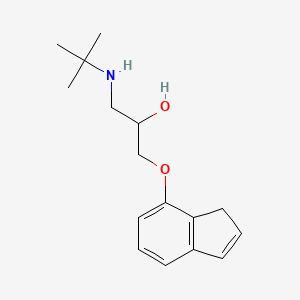
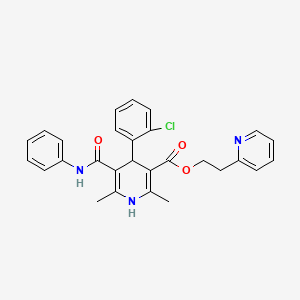
![2-[3-Cyano-5-(3,4-dichlorophenyl)-4,5-dimethylfuran-2-ylidene]propanedinitrile](/img/structure/B1684258.png)
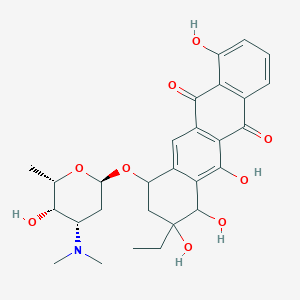
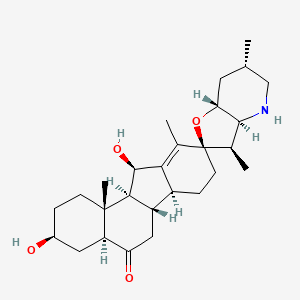
![2-((Z)-((E)-3-ethyl-5-(3-Methylbenzo[d]thiazol-2(3H)-ylidene)-4-oxothiazolidin-2-ylidene)Methyl)-1-Methylpyridin-1-iuM 4-Methylbenzenesulfonate](/img/structure/B1684266.png)
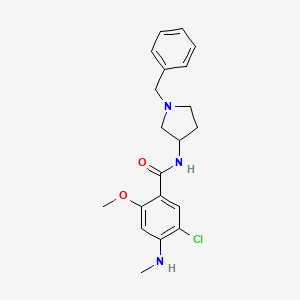
![(Z)-1,4-bis[4-[(3,5-dioxo-1,2,4-oxadiazolidin-2-yl)methyl]phenoxy]-2-butene](/img/structure/B1684269.png)
![N-[4-[(5Z)-5-[2-(4-dimethylaminopiperidin-1-yl)-2-oxoethylidene]-4,4-difluoro2,3-dihydro-1-benzazepine-1-carbonyl]phenyl]-2-phenylbenzamide](/img/structure/B1684270.png)
![1-[3-(3,4-Dichlorophenyl)-3-[2-(1-methyl-4-phenylpiperidin-1-ium-1-yl)ethyl]piperidin-1-yl]-2-(3-propan-2-yloxyphenyl)ethanone](/img/structure/B1684271.png)
